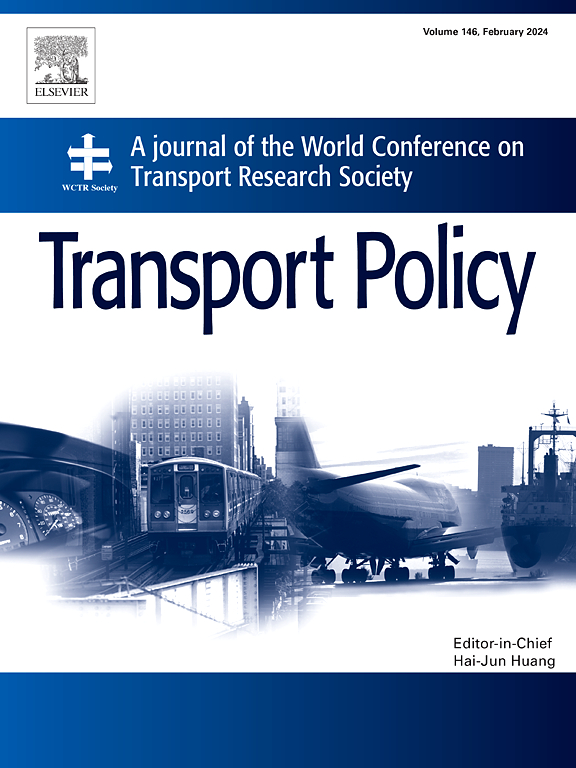Examining the impact of spatial inequality in socio-demographic and commute patterns on traffic crash rates: Insights from interpretable machine learning and spatial statistical models
IF 6.3
2区 工程技术
Q1 ECONOMICS
引用次数: 0
Abstract
Traffic crash rates are often closely related to the region's socio-demographic, commuting behavior, motivated by the risks associated with increased region density and excessive congestion. However, crash rates of different severities may vary considerably due to socio-spatial disparities and the mitigation behaviors adopted across regions. Thus, this study elucidates the intricate effects of socio-demographic dynamics and commuting behavior on overall and fatal traffic crash rates across Florida's counties, with particular emphasis on the underlying factors of spatial inequality. Employing an interpretable machine learning model, specifically eXtreme Gradient Boosting (XGBoost), we demonstrate its superiority in detecting spatial heterogeneity and the complex effects of various factors compared to traditional spatial statistical models, e.g. Spatial Lag Model (SLM) and Multiscale Geographically Weighted Regression model (MGWR). A comprehensive simulation experiment was designed to validate the dependability of modeled fittings, which confirms XGBoost as a reliable alternative to conventional spatial statistical models, particularly when dealing with datasets that including complex effects including spatial lag, spatial heterogeneity, non-linear effects and potential interaction effects. Furthermore, the totally empirical findings for Florida reveal the spatial variations in overall and fatal crash rates, correlating significantly with socio-demographic and commute pattern variables. An endogeneity test has been conducted initially for empirical datasets, accompanied by strategies to eliminate the biasing effect of endogenous variables on subsequent modeling process. Finally, key variables include population demographics, commute duration, education levels, unemployment rates, and intersection density produce heterogeneous effects on overall and fatal traffic crash rates. Notably, the study dispels the conventional belief that higher overall crash rates directly correlate with higher fatal crash rates in the same regions, underscoring the importance of distinct analysis. Policy measures should focus on improving accessibility to road infrastructure and healthcare services, with tailored approaches for sparse and densely populated areas. These findings underscore the need to address spatial inequalities in transportation infrastructure and policy measures to reduce traffic crash rates and improve road safety across all regions.
研究社会人口和通勤模式的空间不平等对交通事故率的影响:来自可解释机器学习和空间统计模型的见解
交通事故率通常与该地区的社会人口、通勤行为密切相关,其动机是与区域密度增加和过度拥堵相关的风险。然而,由于社会空间差异和各区域采取的缓解行为,不同严重程度的碰撞率可能差异很大。因此,本研究阐明了社会人口动态和通勤行为对佛罗里达州各县总体和致命交通事故率的复杂影响,并特别强调了空间不平等的潜在因素。与传统的空间统计模型(如空间滞后模型(SLM)和多尺度地理加权回归模型(MGWR)相比,采用可解释的机器学习模型,特别是极端梯度增强模型(XGBoost),证明了其在检测空间异质性和各种因素的复杂效应方面的优势。设计了一项全面的仿真实验来验证建模配件的可靠性,证实了XGBoost是传统空间统计模型的可靠替代方案,特别是在处理包含空间滞后、空间异质性、非线性效应和潜在交互效应等复杂效应的数据集时。此外,佛罗里达州的完全实证研究结果揭示了总体和致命车祸率的空间差异,与社会人口统计学和通勤模式变量显著相关。首先对经验数据集进行了内生性检验,并提出了消除内生性变量对后续建模过程的偏倚影响的策略。最后,包括人口统计、通勤时间、教育水平、失业率和十字路口密度在内的关键变量对总体和致命交通事故率产生了异质性影响。值得注意的是,这项研究消除了人们的传统观念,即在同一地区,较高的总体撞车率与较高的致命撞车率直接相关,强调了不同分析的重要性。政策措施应侧重于改善道路基础设施和保健服务的可及性,并针对人口稀少和人口稠密的地区采取量身定制的办法。这些调查结果强调,需要解决交通基础设施的空间不平等问题,并采取政策措施,降低所有区域的交通事故率,改善道路安全。
本文章由计算机程序翻译,如有差异,请以英文原文为准。
求助全文
约1分钟内获得全文
求助全文
来源期刊

Transport Policy
Multiple-
CiteScore
12.10
自引率
10.30%
发文量
282
期刊介绍:
Transport Policy is an international journal aimed at bridging the gap between theory and practice in transport. Its subject areas reflect the concerns of policymakers in government, industry, voluntary organisations and the public at large, providing independent, original and rigorous analysis to understand how policy decisions have been taken, monitor their effects, and suggest how they may be improved. The journal treats the transport sector comprehensively, and in the context of other sectors including energy, housing, industry and planning. All modes are covered: land, sea and air; road and rail; public and private; motorised and non-motorised; passenger and freight.
 求助内容:
求助内容: 应助结果提醒方式:
应助结果提醒方式:


